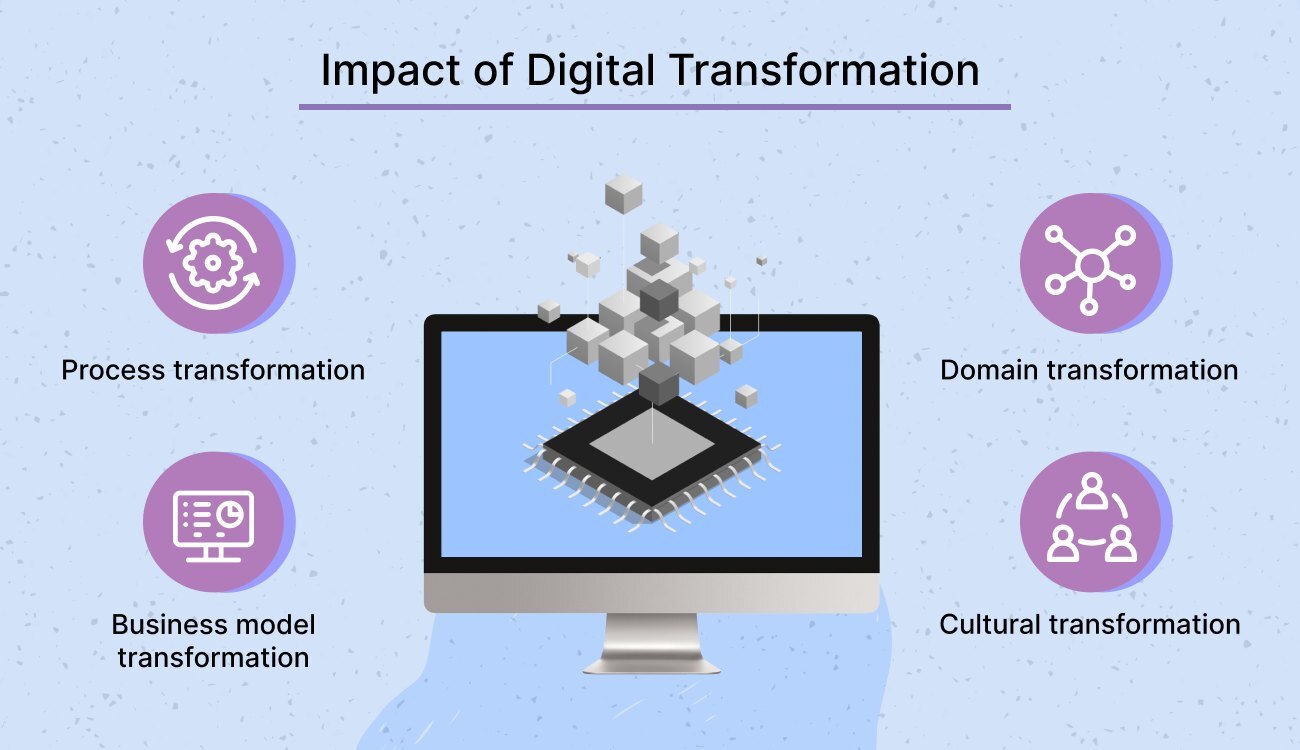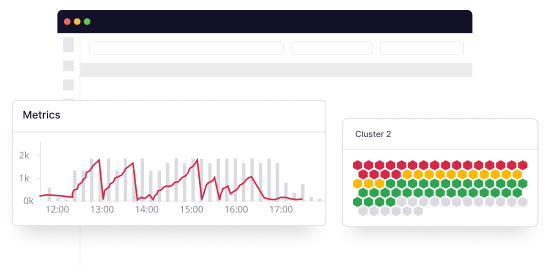Digital transformation is a familiar phrase among IT leaders, to the point of cliche.
However, as more companies adopt distributed, cloud native infrastructures, digital transformation is evolving from a singular event to a continual process—one that companies of all sizes must adopt.
There are a number of reasons why this is the case:
- Changing user expectations requires a rethinking of old operating models
- Market volatility requires agility and responsiveness
- Demands for additional revenue streams incentivizes experimentation and new product development
At the end of the day, digital transformation helps developers, engineers, and IT leaders provide more value to the customers they serve.
In this comprehensive guide, we’ll walk the ins and outs of digital transformation, how it works, key benefits and challenges, and how you can stay ahead of the curve by continually innovating and experimenting within your IT organization.
What is digital transformation?
So what is digital transformation, exactly?
Simply put, digital transformation is the integration of digital technology into all areas of your business—not just your infrastructure, but your processes, business model, and culture.
Digital transformation is not “change for change’s sake.” Instead, it enables organizations to become more agile and innovative, enhancing the value they offer to customers. Plus, as more companies have engaged in digital transformation, it has become a competitive necessity.
But many companies use the term in a trite or meaningless way. So let’s define four key areas where digital transformation most impacts your business.

1. Process transformation
Before you can effectively adopt digital technologies, you need to have a plan to realize their value. Process transformation helps you understand the goals you’re working to achieve, so you can align your transformation initiatives accordingly:
- Define your goals and objectives to determine which specific processes need to be changed
- Assess current processes to understand how to make the changes necessary to achieve your goals
- Seek out solutions that map to your new processes—not the other way around
- Implement your changes, maintaining open communication with all stakeholders to ensure the changes stick
- Monitor and adjust over time to ensure the needle moves in the right direction
2. Business model transformation
In some cases, digital transformation requires a complete upending of the business model. Given the constantly shifting nature of the market, especially certain high-value sectors like retail, tech, and healthcare, business model transformation can provide great benefit to the bottom line:
- Develop new pricing strategies to account for economies of scale that digital transformation provides
- Go after new markets due to increased efficiency and value propositions
- Launch new products and services to serve evolving customer needs and expectations
3. Domain transformation
For many legacy companies, digital transformation can simply mean moving operations and data to the cloud. Domain transformation can help reduce costs, improve scalability, and make the business more agile.
Another key aspect of domain transformation is the move to cloud native observability. As organizations recognize the need for visibility across cloud environments—including microservices, Kubernetes, and other container-based environments—new monitoring and observability services are needed.
Match up with the digital transformation race by implementing full-stack observability.
Of course, this is no simple task and is never done overnight. It involves identifying the workloads and applications which can function in the cloud, migrating your data, then testing and monitoring to ensure that the migration hasn’t negatively impacted the end user.
4. Cultural transformation
The most foundational area of digital transformation is cultural. After all, your digital technology won’t move your business forward unless the people in your organization take ownership and use it to its full potential.
Many organizations struggle to effect change within their culture. In fact, data from HBR states that over 70% of change initiatives fail. Cultural transformation, then, is critical to making your digital transformation stick:
- State your cultural expectations explicitly—clarity is key
- Communicate the benefits behind the change to stakeholders at all levels to build buy-in
- Make sure your leadership is setting the example
- Dedicate resources to cultural change—don’t let it be an afterthought
- Give it time—digital transformation won’t happen overnight
What are the benefits of digital transformation?
Digital transformation both protects your business from risk and opens up new opportunities for revenue and company growth. However, transformation for transformation’s sake does nothing to help your business.
If you want to realize benefits from your digital transformation, it’s critical to ask: how is this going to benefit my customers and their experience?
When you align your business processes at all levels of the customer journey with these expectations, you can avoid chasing “the next big thing.” Instead, you’ll focus on the applications and processes that deliver value to your customers.
What’s more, the role of the CIO is evolving from a support role to a front-line, revenue-generating position. As such, CIOs—and IT leaders at all levels—must understand how to leverage digital transformation not only to improve efficiencies, but also drive innovation that leads to revenue.
Top benefits of digital transformation include:
- Transform the customer experience, building brand loyalty and reducing turnover rates
- Drive data-based insights, enabling decisioning based on facts rather than intuition
- Encourage collaboration among multi-functional and distributed teams
- Increase agility and innovation to respond to changes in the market, key competitor moves, customer requests, and more
- Consolidate processes and operations to improve efficiencies and reduce costs
The ROI of digital transformation efforts can be challenging to measure, as there are many variables and indirect connections to consider.
This is one of the areas where full-stack observability can help. Full-stack observability helps you fill in blind spots by providing complete visibility into your infrastructure’s components, dependencies, metrics, traces, and logs.
As microservices, Kubernetes, containers, etc. become more standard digital practices, full-stack observability helps IT teams understand the performance and health of newly transformed environments.
How is digital transformation impacting IT functions within businesses?
As we mentioned earlier, digital transformation is changing the primary value proposition of an IT department. While technical engineering, development, and support will continue to be core functions, another has entered the fray—revenue generation.
IDG’s 2021 State of the CIO research, which surveyed more than 800 IT and business leaders, demonstrates that 47% of CIOs identify as transformational CIOs—or leaders who cultivate enterprise-wide perspective and business knowledge. 28% are considered business strategists, involved in driving innovation within the organization.
Most notably, 92% of respondents believe the CIO role is digital and innovation-focused. This has resulted in significant changes across the following core business functions.
Business strategy
As digital products become more central to modern business models, IT leadership is taking a stronger role in business strategy. More specifically, IT leaders provide insights needed to improve organizational efficiency—and often implement the necessary changes themselves.
This requires IT leaders to be less siloed and immerse themselves in the business, staying up-to-date on core strategic objectives and initiatives. They must also communicate the value of technology-enabled innovation in business-speak, not IT lingo.
Revenue generation
IT leadership is also increasingly responsible for profit and loss, particularly when it comes to new product and service offerings. Understanding which products to develop requires a deep understanding of customers, the value they realize from your applications and platforms, and how to enhance that value in meaningful ways.
Driving agile business models
In a digital world, IT leaders are more active in building and developing business models. This is the case on both an internal and external level.
Internally, COVID-19 led to the prevalence of distributed teams, requiring IT to build the infrastructure that enables team members to work together effectively. Externally, changing consumer expectations require IT teams to deliver technology speedily, prioritizing work streams, creating minimally viable solutions, and empowering team members to take risks and potentially fail.
What key areas are impacted by digital transformation?
While the full extent of digital transformation will depend on an organization’s specific challenges, demands, and needs, a few factors are constant:
- Customer experience. Working to understand customers in more detail, using technology to fuel customer growth, and creating more customer touchpoints.
- Operational processes. Improving internal processes, enabling employees with digital tools, and collecting data to make more strategic business decisions.
- Business models. Transforming the business by augmenting physical offerings with digital tools and services, introducing digital products, and using technology to provide global shared services.
- Culture and leadership. Focusing on resilience and sustainability, and prioritizing innovation within the organization.
- Employee enablement. Accepting remote work as the norm, enabling employees to accomplish their work while maintaining life balance.
- Data management and security. Treating security as a business imperative, rather than an afterthought.
By improving performance in these key areas, digital transformation enables organizations to become well equipped for the future economy.
The role of observability in digital transformation
According to Era Software’s 2022 State of Observability and Log Management report, observability data volumes are likely to increase anywhere from 2-5X over the coming years. 79% of IT practitioners say that their current tools are insufficient, resulting in ballooning costs if existing tools don’t evolve.
As more companies embrace digital transformation, they’re moving from traditional two-tier application architecture to multi-tier application architecture across multiple cloud environments and managed services. Because the IT doesn’t have direct control over these services, they depend entirely on what the cloud provider reports.
Observability, then, is necessary to mitigate the risks inherent in digital transformation, ensuring that everyone on the team has access to the information they need to make informed decisions.
By bridging the gap between legacy technology and modern approaches to data management, observability gathers insights from high volumes of logs, metrics, and traces to ensure delivery of reliable digital services.

Leverage Middleware to analyze, diagnose & predict issues across your entire stack.
Key challenges in digital transformation
Most of the challenges to digital transformation aren’t technological, but organizational and cultural. The success of digital transformation depends on decisive action on these problems, the most prominent of which are:
- Organizational silos
- Culture of caution, rather that innovation
- Insufficient resources to invest in digital transformation
- Digital skill gaps among the team
- Increased data security concerns arising from distributed information
Most of these challenges boil down to insufficient buy-in from relevant stakeholders, which trickles down to resource allocation and team culture. By ensuring that everyone is on the same page and aligned toward digital transformation, you can help many of these issues resolve themselves.
How to get started with digital transformation
Adopting continual digital transformation may seem overwhelming, but with a clear plan and attainable action steps, you can make significant progress in a short period of time. Below are some best practices and tools that will help you hit the ground running.
Digital transformation best practices
1. Digital twins
These are digital representatives of real-world entities or systems. Employing these can help your team experiment and collect data to support informed business decisions.
2. Privacy
Convenient digital solutions may seem appealing, but often they come at the cost of safety and security. By taking privacy seriously, you can ensure that users and other stakeholders are fully on board with your digital transformation initiatives.
3. Culture
As mentioned earlier, your culture can be an asset or liability to your transformation efforts. Taking the time to lay the groundwork regarding innovation and change can help avoid friction and build consensus among the people you need to move forward.
4. Digital product management
Digital product management involves changing mindsets from projects to products. When you know the markets and industries you serve, you can align each product you ship to those specific needs, generating customer loyalty and reducing churn.
Digital transformation tools
Collaborative tools
Distributed teams require a new approach to collaboration. Using platforms like Google Workplace, Office 365, Jira, Trello, Wrike, or other tools can keep everyone aligned, regardless of where (and when) they’re working.
Communication tools
Communication is directly linked with collaboration. Unfortunately, common collaboration tools like email can’t keep up with fast-paced, distributed environments. Instead, tools like Slack or Microsoft Teams can help manage product updates, involve stakeholders in key decisions, form smaller working groups within the team, and more. Additionally, Zoom, Skype, or Google Meet are critical for maintaining face-to-face interactions, even for teams that are distributed globally.
Next generation intranet platforms
The role of intranet has changed in an increasingly digital and cloud native environment. Modern intranets require the following functionality:
- Integrated content management (CMS)
- Intelligent global search engine
- Native mobile apps
- Fully customizable design
- Multilingual interfaces
- Manageable permissions and governance
- Real-time communication and functionality
An effective, modern intranet enables everyone to store, collect, and centralize all relevant information. Microsoft SharePoint, Workplace from Meta, Happeo, and Friday are all examples of popular intranet platforms.
Recruitment management
Given the impact that skill gaps have on digital transformation, it’s important to recruit for relevant skills, and ensure that your onboarding integrates them into your team as quickly as possible. A well-structured employee onboarding process is crucial for quickly integrating new hires with the necessary skills into your team and maximizing their contribution to the digital transformation. Digital recruitment tools can help you source and screen resumes, manage applicants, and find the best fit for your team.
Observability platforms
As we mentioned earlier, observability is critical to making informed decisions in a digital, cloud native environment. When it comes to choosing an observability platform, embracing a full-stack, unified system is key to analyzing, diagnosing, and predicting issues in time to solve them.
Middleware is an integrated, scalable system that will help you un-silo your data and insights from all your containers, empower you to identify root causes and solve issues in real time, and give you the best value for money with a platform that fits to your specific needs.
Bring all your metrics, logs, and traces into a single timeline, and empower your developers and DevOps to debug and fix the issue faster—reducing downtime and improving the user experience.
Learn more about the Middleware cloud native observability stack by signing up here!



